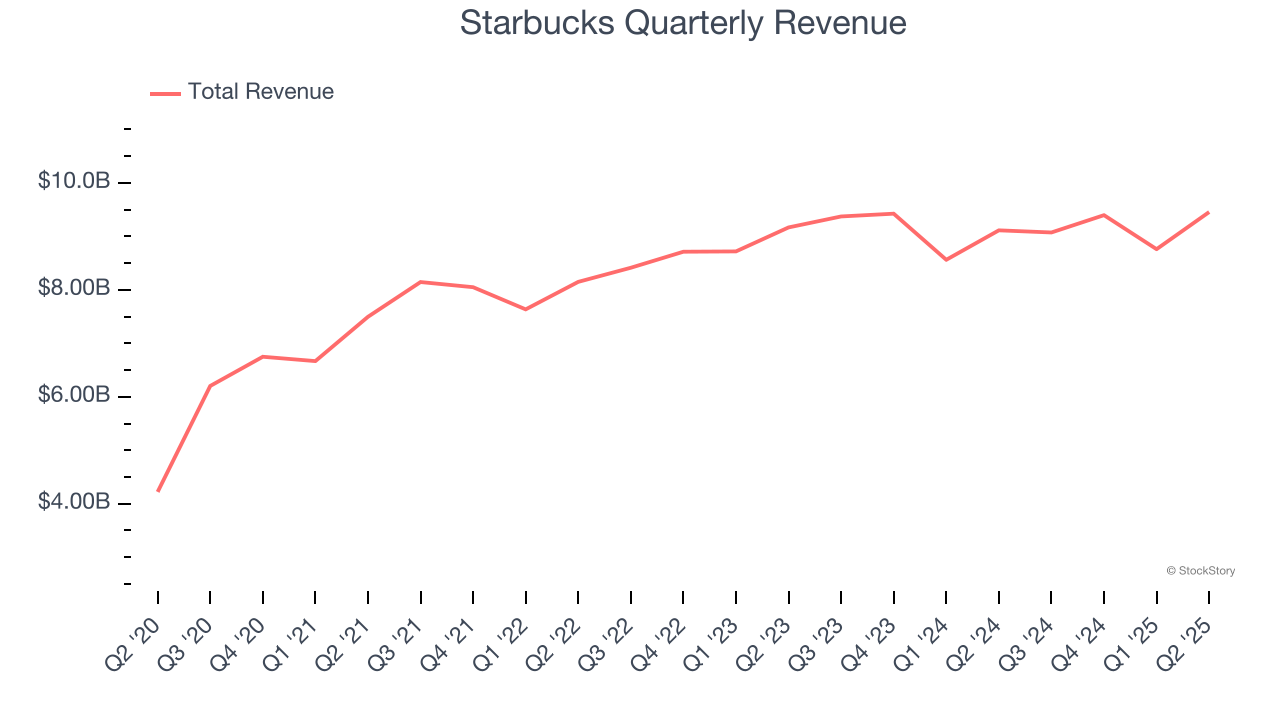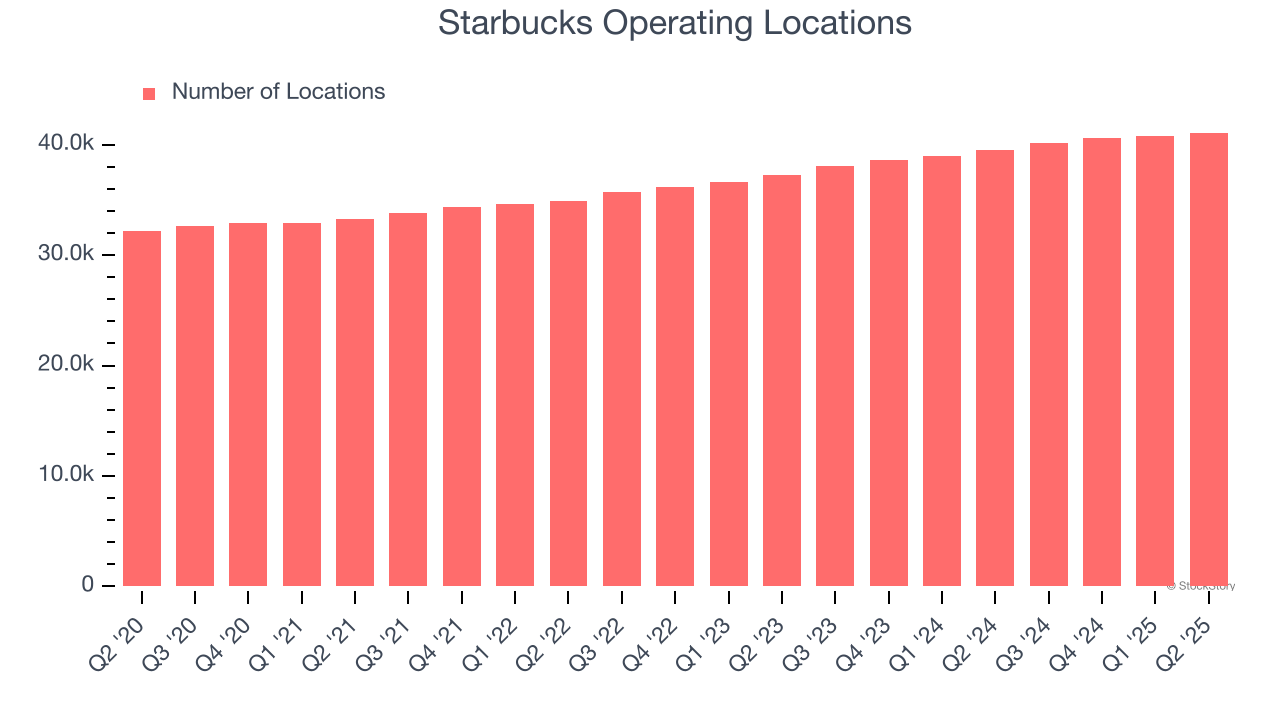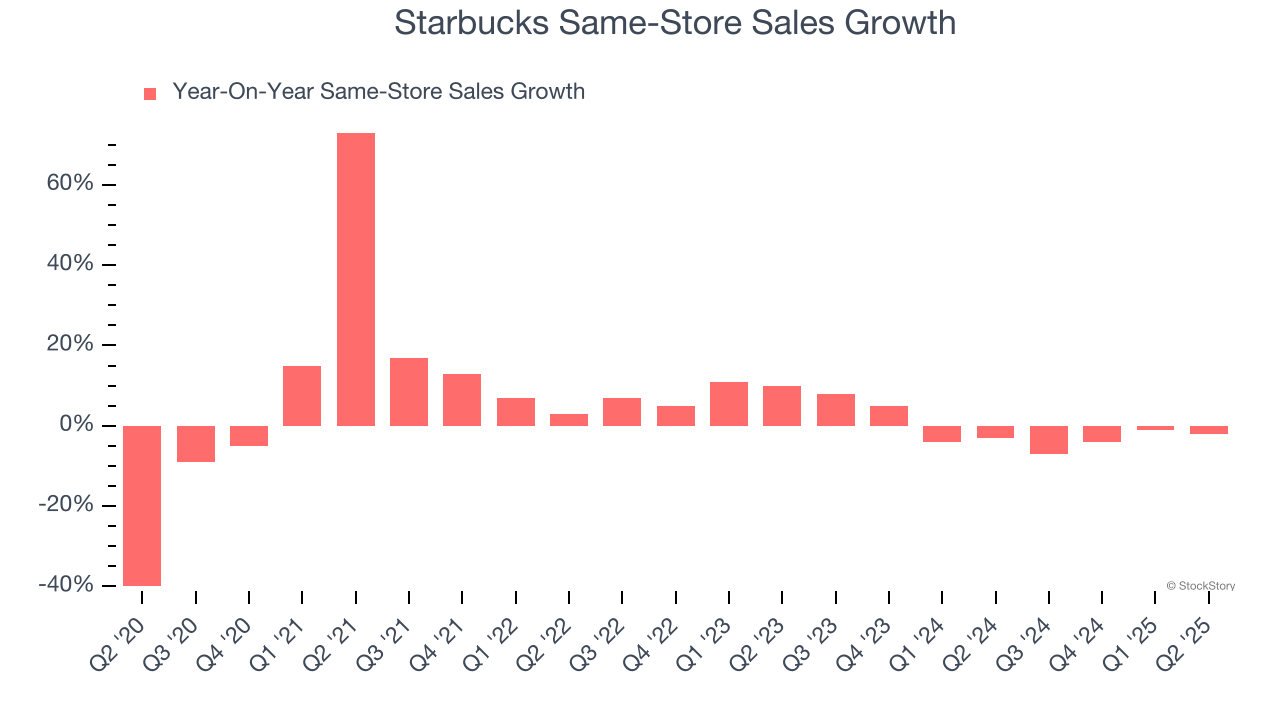
Coffeehouse chain Starbucks (NASDAQ:SBUX) reported Q2 CY2025 results exceeding the market’s revenue expectations, with sales up 3.8% year on year to $9.46 billion. Its non-GAAP profit of $0.50 per share was 22.6% below analysts’ consensus estimates.
Is now the time to buy Starbucks? Find out by accessing our full research report, it’s free.
Starbucks (SBUX) Q2 CY2025 Highlights:
- Revenue: $9.46 billion vs analyst estimates of $9.30 billion (3.8% year-on-year growth, 1.7% beat)
- Adjusted EPS: $0.50 vs analyst expectations of $0.65 (22.6% miss)
- Adjusted EBITDA: $1.36 billion vs analyst estimates of $1.51 billion (14.4% margin, 9.7% miss)
- Operating Margin: 9.9%, down from 16.7% in the same quarter last year
- Free Cash Flow Margin: 16%, up from 10.4% in the same quarter last year
- Locations: 41,097 at quarter end, up from 39,477 in the same quarter last year
- Same-Store Sales fell 2% year on year, in line with the same quarter last year
- Market Capitalization: $106.4 billion
Company Overview
Started by three friends in Seattle’s historic Pike Place Market, Starbucks (NASDAQ:SBUX) is a globally-renowned coffeehouse chain that offers a wide selection of high-quality coffee, beverages, and food items.
Revenue Growth
Reviewing a company’s long-term sales performance reveals insights into its quality. Any business can put up a good quarter or two, but the best consistently grow over the long haul.
With $36.69 billion in revenue over the past 12 months, Starbucks is one of the most widely recognized restaurant chains and benefits from customer loyalty, a luxury many don’t have. Its scale also gives it negotiating leverage with suppliers, enabling it to source its ingredients at a lower cost. However, its scale is a double-edged sword because there is only so much real estate to build restaurants, placing a ceiling on its growth. To expand meaningfully, Starbucks likely needs to tweak its prices, start new chains, or enter new markets.
As you can see below, Starbucks’s sales grew at a tepid 5.9% compounded annual growth rate over the last six years (we compare to 2019 to normalize for COVID-19 impacts).

This quarter, Starbucks reported modest year-on-year revenue growth of 3.8% but beat Wall Street’s estimates by 1.7%.
Looking ahead, sell-side analysts expect revenue to grow 5.2% over the next 12 months, similar to its six-year rate. This projection doesn't excite us and implies its newer menu offerings will not lead to better top-line performance yet.
Unless you’ve been living under a rock, it should be obvious by now that generative AI is going to have a huge impact on how large corporations do business. While Nvidia and AMD are trading close to all-time highs, we prefer a lesser-known (but still profitable) stock benefiting from the rise of AI. Click here to access our free report one of our favorites growth stories.
Restaurant Performance
Number of Restaurants
A restaurant chain’s total number of dining locations often determines how much revenue it can generate.
Starbucks sported 41,097 locations in the latest quarter. Over the last two years, it has opened new restaurants at a rapid clip by averaging 5.7% annual growth, among the fastest in the restaurant sector.
When a chain opens new restaurants, it usually means it’s investing for growth because there’s healthy demand for its meals and there are markets where its concepts have few or no locations.

Same-Store Sales
The change in a company's restaurant base only tells one side of the story. The other is the performance of its existing locations, which informs management teams whether they should expand or downsize their physical footprints. Same-store sales gives us insight into this topic because it measures organic growth at restaurants open for at least a year.
Starbucks’s demand has been shrinking over the last two years as its same-store sales have averaged 1% annual declines. This performance is concerning - it shows Starbucks artificially boosts its revenue by building new restaurants. We’d like to see a company’s same-store sales rise before it takes on the costly, capital-intensive endeavor of expanding its restaurant base.

In the latest quarter, Starbucks’s same-store sales fell by 2% year on year. This performance was more or less in line with its historical levels.
Key Takeaways from Starbucks’s Q2 Results
We enjoyed seeing Starbucks beat analysts’ revenue expectations this quarter. On the other hand, its EBITDA and EPS fell short of Wall Street’s estimates. Overall, this quarter was mixed. The stock traded up 3.1% to $95.80 immediately after reporting.
So should you invest in Starbucks right now? When making that decision, it’s important to consider its valuation, business qualities, as well as what has happened in the latest quarter. We cover that in our actionable full research report which you can read here, it’s free.
